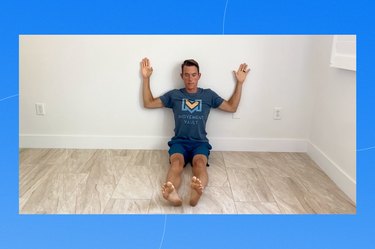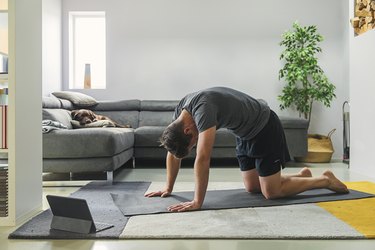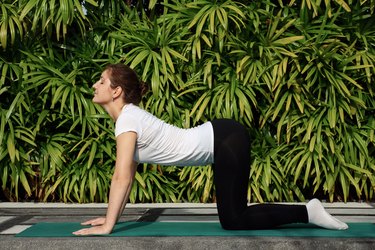

Scrunched shoulders, slouched backs and flexed necks — most of us twist and tense our muscles into pretty prickly positions while we sit all day. But if you're keyed up in front of a keyboard for hours at a time, your body will pay the price.
The temporary tightness you feel in your muscles and joints after sitting for a prolonged period can grow into a more permanent problem.
Video of the Day
Over time, these stiff neck, back and shoulder muscles may lose mobility and be forced to compensate, moving in ways they weren't designed to move, says Grayson Wickham, DPT, CSCS, a certified strength and conditioning specialist, physical therapist and founder of the Movement Vault. The result is often pain, injury and poor posture.
But you don't just have to sit there and take it. Simply get off your butt and walk to a wall.
Wall slides — a mobility move that involves sliding your arms up and down a wall (hence the name) — can help you undo the damage that excessive sitting does to your spine and promote better posture.
All you need is a wall, so you can easily work in wall sits any time during the day – at home, at the office, or wherever there's a sturdy structure to lean on. For best results, do this move twice daily, performing 20 reps at a time, Wickham says.
How to Do a Wall Slide
- Sit upright with the back of your hips and shoulders up against a wall.
- Extend your legs straight in front of you the entire time.
- Keep the back of your head touching the wall while performing a mini chin tuck (think about trying to make a double chin). Hold this position throughout the movement.
- Brace your core by pressing your low back into the wall. This will bring your rib cage downward.
- Bring your arms out to your sides and against the wall so that there is a 90-degree angle between your upper arms and torso. Your elbows should also be bent at a 90-degree angle.
- While pressing the backs of your arms against the wall, raise your arms overhead as far as possible. Try not to let your arms move off the wall.
- Slowly lower your arms back to the starting position. That’s 1 rep.
4 Reasons to Do Wall Slides Every Day
Here are just a few reasons you should incorporate wall slides into your daily routine:
1. They Improve T-Spine Mobility
Located in the upper and middle part of the back, your thoracic spine (or t-spine for short) helps keep your body upright and stable. But when you sit (read: slouch) all day in front of a screen, your t-spine really takes a hit.
"Wall slides can improve upper-back mobility by activating your upper back extensor muscles and keeping your upper back relatively straight (versus hunched over)," Wickham says.
"During the movement, you're essentially reversing the flexed upper back position most people have while sitting," he says.
2. They Support Good Posture
From headaches and heartburn to breathing problems and back pain, poor posture can produce a plethora of unhealthy side effects. To prevent pain and stay injury-free, focusing on proper posture is of prime importance.
Wall slides can help you do just that by training your body to sit straighter and more upright, Wickham says.
"They will also open up and stretch out the front of your shoulder and chest muscles, especially your pectoralis muscles, while the backs of your shoulders contract and activate," Wickham says. In other words, they help counteract the common chest caving and shoulder slouching that occurs while sitting.
3. They Reduce Neck and Back Pain
Wall slides activate and contract your upper back extensor, lower neck extensor and deep neck flexor muscles, and keep your core muscles braced, Wickham says. This can all help to improve your sitting posture.
And by putting your joints in a better position, you decrease the likelihood of becoming tight and tense in these areas and accompanying muscles, Wickham explains. Translation: Long, loose, limber muscles mean fewer aches and pains in places like your neck and back.
4. They Improve Proprioception
"Wall slides can also help with proprioception — or body awareness — and can help you figure out what better posture really feels like," Wickham says.
This is important because you'll be able to tell if you're not sitting in proper alignment and can adjust accordingly, nipping bad posture in the bud.
Tip
In addition to doing wall slides, switch up your sitting position as often as possible (get up and move every 20 minutes) to prevent pain and tight muscles, Wickham says.
And if you can, sit on the ground instead of a chair. This improves your mobility because you can move your hips and legs into multiple positions like cross-legged, one leg out, 90-90 pose or sitting splits, Wickham says.


